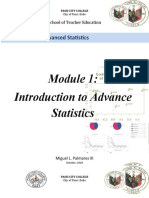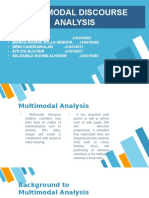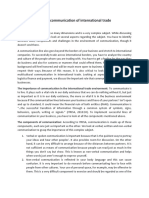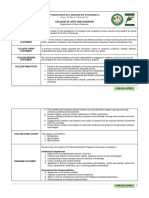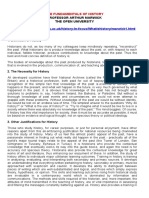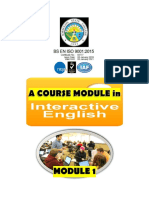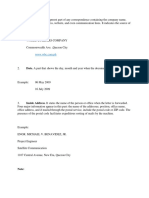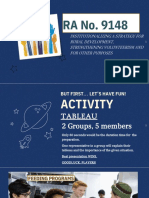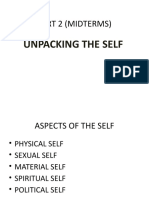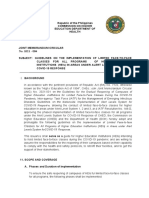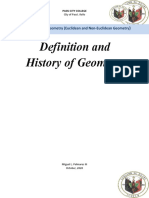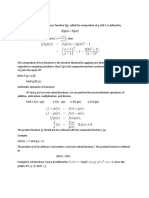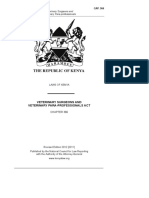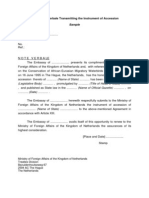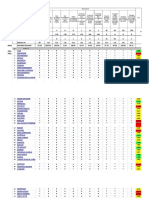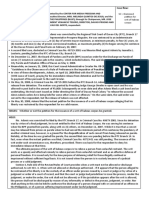GE 102 Purposive Communication: School of Teacher Education
GE 102 Purposive Communication: School of Teacher Education
Uploaded by
Miguel PAlmaresCopyright:
Available Formats
GE 102 Purposive Communication: School of Teacher Education
GE 102 Purposive Communication: School of Teacher Education
Uploaded by
Miguel PAlmaresOriginal Title
Copyright
Available Formats
Share this document
Did you find this document useful?
Is this content inappropriate?
Copyright:
Available Formats
GE 102 Purposive Communication: School of Teacher Education
GE 102 Purposive Communication: School of Teacher Education
Uploaded by
Miguel PAlmaresCopyright:
Available Formats
PASSI CITY COLLEGE
City of Passi, Iloilo
School of Teacher Education
GE 102
PURPOSIVE COMMUNICATION
MODULE 11
An Overview:
This provides the development of student’s communicative competence and enhances their cultural and
intercultural awareness through multi-modal tasks that provides them opportunities for communicating effectively
and appropriately to a multicultural audience in a local or global context.
It equips students with tool for critical evaluation of a variety of texts and focuses on the power of language and
the impact of images to emphasize the importance of conveying messages responsibly.
Module Outcomes:
discussed the best practices of conducting a meeting;
familiarized himself/herself with the procedures in
conducting a meeting; and
discussed ways to conduct effective meeting.
RHIZA G. ESPINOSA, LPT PAGE 1
GE 102: PURPOSIVE COMMUNICATION MODULE 11
Good day!
In this module, we will discuss the Communication
for Work Purposes. Let’s start!
MEETING
Meeting is a technique of bringing a group of individuals together to work for a common purpose. In
meetings, the individual contributions are synergized to maximize the potential by bringing together to pursue a
common focus, better decisions, commitment, support, and implementation. To achieve these, a meeting must be
effective. An effective meeting requires an action-oriented focus. All members in a meeting must share the focus,
understand one another's role, and use a common process geared toward specific outcomes (Saylor, 2006).
The conduct of meetings within a club, organization, team, or committee is necessary for the maintenance of
effective communication and democracy. The prime purposes of conducting meetings are to share ideas and to come
up with a consensus among members (USQ Student Guild, n.d.).
Usually, conducting a meeting follows certain procedures. These procedures are set up to improve the
efficiency in the conduct of the business of the meeting while giving protection to the rights of members present.
Likewise, it enables every person in the meeting to have an equal right to be heard and to have the opportunity to
have his/her viewpoint considered. It enables every person present to have an equal right to vote on the issues and
to help in the decision-making. Thus, club members must be aware of the meeting procedures and be kept informed
of any changes (USQ Student Guild, n.d.).
Meetings are very common in organizations. They serve as channels of oral communication among the
members of the meeting. They are supported by written communication like notices to bring people together, agenda
to structure the meeting, minutes to record the proceedings and reports to pass the information to the higher
authorities.
A meeting is get-together of a group of persons to discuss ways and means to deal with a specific time-
bound task assigned. The members of the group share common experience, common concern and common interests.
Unless there is clarity in the purpose, the meetings may turn out to be a frustrating and wasteful effort. Meetings
enable face to face contact of number of people at the same time.
Purpose of Meeting
To convey information to the members.
To gather information from the members.
To exchange ideas and experiences among the members.
To brief members on plans, working and performance and to instruct members.
To discuss problems and issues of common interest. To persuade members to accept changes.
To resolve conflicts and confusions.
To take decisions of matters affecting the group or the organization.
To generate a positive attitude among the participants.
The six general types of meetings:
Status Update Meetings
Information Sharing Meetings
Decision Making Meetings
Problem Solving Meetings
RHIZA G. ESPINOSA, LPT PAGE 2
GE 102: PURPOSIVE COMMUNICATION MODULE 11
Innovation Meetings
Team Building Meetings
Minutes of the Meeting
The minutes of the meeting refer to the documented or recorded discussion of a certain gathering of select
attendees. Every office, regardless of its nature, always conducts a meeting; such meeting could be monthly,
quarterly, semestral, or yearly. At times, it depends on the urgency of the agenda. At the end of every meeting, the
minutes of the meeting are prepared.
The minutes of the meeting are the official written or recorded documentation intended to inform
attendees and non-attendees about what was discussed or what happened during a meeting. The minutes are
generally taken by a designated staff during the proceedings. The meeting can be audio recorded or video recorded.
The assigned recorder may use shorthand notation and then prepare the minutes and issue them to the participants
afterwards. The organization may have its own rules regarding the content of the minutes.
The ideal minutes of the meeting contain the following:
1. Names of attendees
2. Agenda items covered
3. Decisions made by attendees
4. Follow-up actions committed by attendees
5. Deadlines for the completion of commitments
6. Other events or discussions worth documenting for the future review
Things to remember in preparing the minutes of the meeting:
1. The minutes should be concise and should include only a summary of the decisions. A verbatim report
(transcript) is not necessary, unless the organization requires it.
2. The format of the minutes can vary depending on the standards established by the organization. (A sample
format is provided in the succeeding page)
3. These days, minutes are recorded on an electronic device, such as laptop or iPad so it can be disseminated to
participants electronically at the end of the meeting. This way, the participants can immediately take note
of their commitments and deadlines, and can raise questions or seek clarification. However, if this is not
possible because the transcriber wants to transcribe the minutes or check them for errors, he/she should
disseminate the minutes within 24 hours following the meeting.
4. The designated recorder should always review the prior meeting's minutes at the start of the next meetings
so that participants can check them for accuracy and next steps.
Below are the procedures to follow in conducting a meeting.
1. Prior to the Conduct of a Meeting
a. Send an adequate notice of the meeting to all members of the meeting.
b. Enclose the minutes of the previous meeting in the notice if they have not already been sent one.
RHIZA G. ESPINOSA, LPT PAGE 3
GE 102: PURPOSIVE COMMUNICATION MODULE 11
c. Collect reports from club officers to be included in the agenda of the meeting.
d. Call for and receive nominations for club positions.
e. Arrange for the printing of the completed annual report.
f. Arrange for the guest speaker (if there is any).
g. Arrange the hospitality, venue, date, and time of the meeting.
h. Remind the members of the meeting before the day of the meeting the specified day, time, and venue.
2. Parts of the Business Meeting.
a. Call to order. Usually, the president holds a gavel, rises, and says, "The meeting will please to come to
order
b. Roll call. Here, the secretary of the organization checks the attendance of the members of the
meeting. Through this, the quorum will be determined. If the quorum is met, the meeting Will proceed;
otherwise, it Will be postponed.
c. Reading and approval of previous minutes. The president will request the secretary to read or
everybody will be given time to review the minutes of the previous meeting. After reading the previous
minutes, the president will ask for any additions or corrections. If there are none, the president says,
"If there are no corrections or additions, they stand approved as read." If there are corrections or
additions, they are made, and the president says, "The minutes stand approved as corrected or added."
d. Reading of correspondence. The president asks the secretary to read any correspondence.
e. Treasurer's report. President will ask the treasurer to give the financial report.
f. Committee reports. President will call upon the chairperson of each committee to give a report or
update.
g. Unfinished business. Anything left over from previous meeting will be reopened and should be discussed.
h. New business. Any club member may bring new business before the club, or the president may state the
business and ask for a motion on it.
i. Announcements. Announce all upcoming events, including the next meeting. It will include the time, place,
what will be done, and what materials the members need to bring.
j. Adjournment. Any member may move the meeting to adjourn. The motion is voted upon. Or the president
may say, "There being no other business, the ins is adjourned."
Strategies for Effective Meetings
You want an efficient and effective meeting, but recognize that group communication by definition can chaotic kind
unpredictable. To stay on track, consider the following strategies:
RHIZA G. ESPINOSA, LPT PAGE 4
GE 102: PURPOSIVE COMMUNICATION MODULE 11
Send out the last meeting's minutes one week before the next meeting*
Send out the agenda for the current meeting at least one week in advance.
Send out reminders for the meeting the day before and the day of the meeting.
Schedule the meeting in Outlook or a similar program so everyone receives a reminder,
Start and end your meetings on time.
Make sure the participants know their role and requirements prior to the meeting.
Make sure all participants know one another before discussion starts
Formal communication styles and reference to the agenda can help reinforce the time frame and tasks.
Make sure notes taken the at the meeting are legible and can be converted to minutes for distribution later.
Keep the discussion on track, and if you are the chair meeting, don't hesitate to restate a point to
interject and redirect the attention back to the next agenda point.
If you are the chair, draw a clear distinction between on-topic discussions and those that are more personal,
individual, or off topic.
Communicate your respect and appreciation for everyone’s time and effort.
Clearly communicate the time, date and location or means of contact for the next meeting
AGENDA
Agenda is a document that outlines the contents of a forthcoming meeting. Effective agenda is one of the
most important elements for a productive meeting. It is usually sent along with the notice of the meeting, which
gives the participants an opportunity to come prepared for the upcoming discussions or decisions.
Agenda aid the process of meeting by putting the meeting plan into a permanent, written form. A good meeting
agenda serve as a guide to participants, making the meeting more efficient and productive. Since agenda has a set
order, it helps the chairperson to conduct the meeting smoothly. It ensures that only matters relevant to that
particular meeting are discussed. It can be used as a checklist to ensure that all the information is covered. It also
facilitates the preparation of the minutes.
The agenda is usually prepared by the Secretary and Chairperson
****End of Discussion****
References:
Martinez, R., (2019), Purposive Communication.
Magan, R.,et al (2018), Purposive Communication in the 21st Century
Pilapil, E., et al (2018), Purposive Communication
Activity:
Directions: List at least 5 agenda/ topic that can be included in the following
1. First meeting of the Parents-Teacher Association
2. December monthly Meeting of Faculty Members.
3. First general Meeting of Student Body Organization
Assessment:
Directions: Explain the following on your own understanding. (5 points each)
1. Why minutes of the meeting important?
2. What is the purpose of conducting a meeting?
3. Does a meeting help an individual improves his/her communication skills? Explain
4. As an individual, how are you going to participate in a meeting? Cite an example and explain
RHIZA G. ESPINOSA, LPT PAGE 5
GE 102: PURPOSIVE COMMUNICATION MODULE 11
You might also like
- Module 1 Advance StatisticsDocument13 pagesModule 1 Advance StatisticsMiguel PAlmares100% (2)
- LT Bill 46001160003 201512Document2 pagesLT Bill 46001160003 201512Santanu DasNo ratings yet
- Communication For Work PurposesDocument53 pagesCommunication For Work PurposesJames RomaNo ratings yet
- Lesson 3 Communication EthicsDocument5 pagesLesson 3 Communication Ethicsflor minozaNo ratings yet
- LNC-WK.14-15 Communication For Academic PurposesDocument9 pagesLNC-WK.14-15 Communication For Academic PurposesNovelyn Degones DuyoganNo ratings yet
- Multimodal DADocument18 pagesMultimodal DAKrisnandri Aji PratamaNo ratings yet
- Boundaries of The Self OnlineDocument41 pagesBoundaries of The Self OnlineKaren Anne C. QuingNo ratings yet
- Chapter 3 Public SpeakingDocument24 pagesChapter 3 Public SpeakingzY kincHNo ratings yet
- Varieties and RegistersDocument3 pagesVarieties and RegistersAhron CulanagNo ratings yet
- NSTP CWTS ModuleDocument42 pagesNSTP CWTS ModuleTrisha Anne Aica RiveraNo ratings yet
- Purposive Communication PPT (Topic 1 Final)Document18 pagesPurposive Communication PPT (Topic 1 Final)Renz LaraNo ratings yet
- Role of Communication in International TradeDocument3 pagesRole of Communication in International TradeShawonAshrafNo ratings yet
- Writing As A ProcessDocument23 pagesWriting As A ProcessAlthea OrtizNo ratings yet
- STRATHRM Lesson 3 - Recruitment and SelectionDocument53 pagesSTRATHRM Lesson 3 - Recruitment and SelectionNUEVA Ma. Charlotte P.No ratings yet
- GE8 EthicsDocument15 pagesGE8 EthicsSir AronNo ratings yet
- GE 5 Lesson 1Document2 pagesGE 5 Lesson 1Angelica AbogandaNo ratings yet
- Purposive Communication Module 9Document4 pagesPurposive Communication Module 9Alvin TorzarNo ratings yet
- Fundamentals of History & Understanding The DisciplinesDocument8 pagesFundamentals of History & Understanding The DisciplinesGeraldine Mae100% (1)
- Activity 7 Purposive CommunicationDocument1 pageActivity 7 Purposive CommunicationLovejean Cortez0% (1)
- Business Meeting ProtocolsDocument19 pagesBusiness Meeting ProtocolsKaira QuilinderinoNo ratings yet
- A COURSE MODULE in Eng322 Module 1 Lesson 2aDocument9 pagesA COURSE MODULE in Eng322 Module 1 Lesson 2aerickson hernanNo ratings yet
- NSTP-CWTS Departmental Course Outline and Learning Plan For Flexible LearningDocument10 pagesNSTP-CWTS Departmental Course Outline and Learning Plan For Flexible Learningdranreb avelinoNo ratings yet
- Module 4 Communication in Various Purposes Lesson 5 THE DEBATEDocument7 pagesModule 4 Communication in Various Purposes Lesson 5 THE DEBATEClarence Escopete100% (1)
- Business Meeting ProtocolsDocument10 pagesBusiness Meeting ProtocolsKathleen Anne LandarNo ratings yet
- Let's Do This: Directions: Explain The Use of The Following Materials in CommunicationDocument3 pagesLet's Do This: Directions: Explain The Use of The Following Materials in CommunicationELISHA RUTH BARAOIDANNo ratings yet
- Local and Global Communication in Multicultural Settings-2020Document33 pagesLocal and Global Communication in Multicultural Settings-2020Gurjit BrarNo ratings yet
- Online Examination For Argumentation and DebateDocument2 pagesOnline Examination For Argumentation and Debatejetlee estacionNo ratings yet
- Module 4 - Evaluating Messages and ImagesDocument10 pagesModule 4 - Evaluating Messages and ImagesKyle Reuben BronNo ratings yet
- Unit Five:: Business Letter WritingDocument34 pagesUnit Five:: Business Letter WritingKai LonNo ratings yet
- Lesson 5 Purposive CommunicationDocument4 pagesLesson 5 Purposive CommunicationABEL, CHARLYN JOY LUARNo ratings yet
- Communication Within A CompanyDocument13 pagesCommunication Within A CompanyKristine G. BatanesNo ratings yet
- Corporate Culture and Professional COMMUNICATIONDocument28 pagesCorporate Culture and Professional COMMUNICATIONFrancis RaagasNo ratings yet
- Purposive CommunicationDocument28 pagesPurposive CommunicationGlyza Marie Sederio ButronNo ratings yet
- Basic Economics With Taxation and Agrarian Reform: Dr. Vicente S. Betarmos, JRDocument11 pagesBasic Economics With Taxation and Agrarian Reform: Dr. Vicente S. Betarmos, JRPlatero RolandNo ratings yet
- CHAPTER 6: Microsoft Excel - Intermediate: ObjectivesDocument19 pagesCHAPTER 6: Microsoft Excel - Intermediate: ObjectivesEA BuoNo ratings yet
- Understanding The Self FinalDocument33 pagesUnderstanding The Self FinalCaila Mae AnguloNo ratings yet
- Language RegistersDocument18 pagesLanguage RegistersAbegail MalupengNo ratings yet
- CWTS LTS Specific Module 1 Self and Filipino Society Specific ModuleDocument24 pagesCWTS LTS Specific Module 1 Self and Filipino Society Specific ModuleRichard M. MarzanNo ratings yet
- PC Lesson 1 FINAL PDFDocument10 pagesPC Lesson 1 FINAL PDFJoshua Miguel Ganseco100% (1)
- C06Document9 pagesC06Claire ElyseNo ratings yet
- NSTP 3Document2 pagesNSTP 3Angelica VidaNo ratings yet
- What Are The Communication Models? Why Do You Think They Were Introduced? There Are A Total of 5 Communication ModelDocument2 pagesWhat Are The Communication Models? Why Do You Think They Were Introduced? There Are A Total of 5 Communication ModelGrace Pascual100% (1)
- City College of Tagaytay: Republic of The PhilippinesDocument9 pagesCity College of Tagaytay: Republic of The PhilippinesJeff Jeremiah PereaNo ratings yet
- Business LetterDocument5 pagesBusiness LetterBeugh RiveraNo ratings yet
- Culturally Sensitive and Bias Free Language BSED I ENGLISH 1Document28 pagesCulturally Sensitive and Bias Free Language BSED I ENGLISH 1Diana PilacNo ratings yet
- Purcomm 3Document7 pagesPurcomm 3Richelle R. SantosNo ratings yet
- Ethical and Social Dimensions of Science and TechnologyDocument5 pagesEthical and Social Dimensions of Science and TechnologyNathan TanNo ratings yet
- NSTPDocument25 pagesNSTPKyla CastroNo ratings yet
- English A Prelim ModuleDocument9 pagesEnglish A Prelim ModuleJian P MendozaNo ratings yet
- Part 2 (Midterms) : Unpacking The SelfDocument19 pagesPart 2 (Midterms) : Unpacking The SelfDarwin CauilanNo ratings yet
- Review of Linguistic Components of LanguageDocument22 pagesReview of Linguistic Components of Languagejhna mggyNo ratings yet
- Mental DevelopmentDocument2 pagesMental DevelopmentJoan Quitaleg100% (1)
- Purposive CommunicationDocument28 pagesPurposive CommunicationBAI XYRYLL SANANGNo ratings yet
- Annual Report PPT FinalDocument23 pagesAnnual Report PPT FinalManish Jaiswal100% (1)
- Local and Global Language Multicultural SettingsDocument6 pagesLocal and Global Language Multicultural SettingsKatVlogsss100% (2)
- Communication and GlobalizationDocument6 pagesCommunication and GlobalizationPaopao MacalaladNo ratings yet
- PURCOM3&4Document19 pagesPURCOM3&4Mycah BolusanNo ratings yet
- Activity No. 11 SWOT AnalysisDocument2 pagesActivity No. 11 SWOT AnalysisCecel Yuboc100% (1)
- Chapter Six Communication For Various PurposesDocument8 pagesChapter Six Communication For Various PurposesNiña Jhayne BoralNo ratings yet
- 1-Communication and Globalization & World EnglishesDocument22 pages1-Communication and Globalization & World EnglishesGerald Yanag MarianoNo ratings yet
- Business CommunicationDocument21 pagesBusiness CommunicationAbhie GhailNo ratings yet
- Notes - BC - FY BCOM Sem II - AT PDFDocument25 pagesNotes - BC - FY BCOM Sem II - AT PDFAbigail IreneNo ratings yet
- Module 9Document2 pagesModule 9Miguel PAlmaresNo ratings yet
- National Service Training Program 1 Vivian G. PadernalDocument3 pagesNational Service Training Program 1 Vivian G. PadernalMiguel PAlmaresNo ratings yet
- CHED DOH JMC No. 2021 004Document31 pagesCHED DOH JMC No. 2021 004Miguel PAlmaresNo ratings yet
- Passi City College Passi City, Iloilo School of Teacher Education Module in National Service Training Program I (CWTS I)Document4 pagesPassi City College Passi City, Iloilo School of Teacher Education Module in National Service Training Program I (CWTS I)Miguel PAlmaresNo ratings yet
- Module Calculus IIIDocument11 pagesModule Calculus IIIMiguel PAlmaresNo ratings yet
- Module 1 Modern GeometryDocument11 pagesModule 1 Modern GeometryMiguel PAlmares75% (4)
- Module 1 Action Research in MathematicsDocument16 pagesModule 1 Action Research in MathematicsMiguel PAlmaresNo ratings yet
- Module 1 Advance StatisticsDocument11 pagesModule 1 Advance StatisticsMiguel PAlmaresNo ratings yet
- City of Passi. IloiloDocument1 pageCity of Passi. IloiloMiguel PAlmaresNo ratings yet
- Operations With FunctionsDocument1 pageOperations With FunctionsMiguel PAlmaresNo ratings yet
- The Last The Last: "Love Doesn't Mean Happiness, It Also Need Your Patience and SacrificesDocument4 pagesThe Last The Last: "Love Doesn't Mean Happiness, It Also Need Your Patience and SacrificesMiguel PAlmaresNo ratings yet
- Find Domain Range and FunctionDocument3 pagesFind Domain Range and FunctionMiguel PAlmares50% (2)
- Section 4.3 Riemann Sums and Definite IntegralsDocument38 pagesSection 4.3 Riemann Sums and Definite IntegralsMiguel PAlmaresNo ratings yet
- QuestionnaireDocument5 pagesQuestionnaireMiguel PAlmaresNo ratings yet
- Cap 366 Vet Surgeons ActDocument39 pagesCap 366 Vet Surgeons ActNaphtal MwanzikiNo ratings yet
- Krell V Henry (1903) 2 KB 740 Extract-2Document3 pagesKrell V Henry (1903) 2 KB 740 Extract-2mjhpooNo ratings yet
- Panaguiton Vs DOJDocument1 pagePanaguiton Vs DOJJelaine AñidesNo ratings yet
- UNDP OAI Charter ENG 2022Document7 pagesUNDP OAI Charter ENG 2022Claudio MotaNo ratings yet
- Polity 3Document12 pagesPolity 3vishalbharati10230No ratings yet
- General Guidelines of Arrest and Search From PNP ManualDocument5 pagesGeneral Guidelines of Arrest and Search From PNP Manualzordi607No ratings yet
- MCQ Question Bank Administrative LawDocument13 pagesMCQ Question Bank Administrative Lawshubham kumarNo ratings yet
- Samanvaya Law & PartnersDocument6 pagesSamanvaya Law & PartnersROHIT YADAVNo ratings yet
- LLB 3 Sem Banking Law 4917 21 Feb 2022Document3 pagesLLB 3 Sem Banking Law 4917 21 Feb 202219umt077No ratings yet
- Website Subpoena Instructions 11.1.2019Document2 pagesWebsite Subpoena Instructions 11.1.2019Mark RiveraNo ratings yet
- Garcia Doj Soi STATEMENT OF INTEREST OF THE UNITED STATES03-04-13Document13 pagesGarcia Doj Soi STATEMENT OF INTEREST OF THE UNITED STATES03-04-13Michael ZhangNo ratings yet
- October 2022 RFBT Preweek Handout Number 1 With Answer Final VersionDocument16 pagesOctober 2022 RFBT Preweek Handout Number 1 With Answer Final VersionNot ConradNo ratings yet
- 2019 P T D 1780Document4 pages2019 P T D 1780haseeb AhsanNo ratings yet
- Presentation By: Sneha Shah Kunal Bhatt Sri Harsha Reddy Swetha Rani Puneeth Gupta Anshu Bafna Santosh Kumar & Hardik DeliwalaDocument18 pagesPresentation By: Sneha Shah Kunal Bhatt Sri Harsha Reddy Swetha Rani Puneeth Gupta Anshu Bafna Santosh Kumar & Hardik DeliwalaharrdiikNo ratings yet
- 2704795-Oath of The Seelie CourtDocument4 pages2704795-Oath of The Seelie Courtdorkydelphi98100% (3)
- Model Note Verbale Transmitting The Instrument of Accession: SampleDocument1 pageModel Note Verbale Transmitting The Instrument of Accession: SampleNatasa BorsNo ratings yet
- (WWW - Entrance-Exam - Net) - Tamil Nadu Open University-BBA 1st Year-Financial and Management Accounting Sample Paper 1Document10 pages(WWW - Entrance-Exam - Net) - Tamil Nadu Open University-BBA 1st Year-Financial and Management Accounting Sample Paper 1Ankita PantNo ratings yet
- Daniel John Brader and Others V Commerzbank AG (2013) SGHC 284Document37 pagesDaniel John Brader and Others V Commerzbank AG (2013) SGHC 284JYhkNo ratings yet
- RA 8484 - Access Devices ActDocument5 pagesRA 8484 - Access Devices ActWilbert ChongNo ratings yet
- Designing An Effective Incentive System: Name: Ravi PatelDocument2 pagesDesigning An Effective Incentive System: Name: Ravi PatelRavi PatelNo ratings yet
- RFI For OrogunDocument1 pageRFI For Orogunoseni momoduNo ratings yet
- RS98 - Deepak Raj Joshee and Rajesh K KatuwalDocument20 pagesRS98 - Deepak Raj Joshee and Rajesh K KatuwalPrajwal BaralNo ratings yet
- Surf Station Extention Draft of KrishanthDocument18 pagesSurf Station Extention Draft of KrishanthNirosha. GunawardenaNo ratings yet
- Allotment of Plots HSVP PolicyDocument5 pagesAllotment of Plots HSVP PolicyShamsherNo ratings yet
- Info On BondsDocument29 pagesInfo On BondsMaryUmbrello-Dressler100% (3)
- Format Penilaian Balita SehatDocument54 pagesFormat Penilaian Balita SehatWidi AstutiNo ratings yet
- Regenerative Agriculture Conference - Booking Form - PatDocument1 pageRegenerative Agriculture Conference - Booking Form - PatPatrick ChipaseNo ratings yet
- IBYDE FV S G SDP enDocument64 pagesIBYDE FV S G SDP enIbbu MohdNo ratings yet
- Adonis v. Tesoro Rule 102Document1 pageAdonis v. Tesoro Rule 102rhod leysonNo ratings yet
